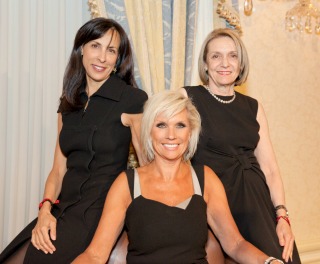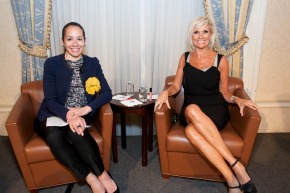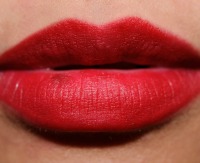
2014-05-14 22:17:55
What Makes MAC Tick
2014-05-14 22:17:55
By Jamie Matusow, Editor
Colorful anecdotes punctuated the MAC presentation given by Karen Buglisi Weiler, global brand president of MAC Cosmetics, at CEW’s event on April 29 at The Harmonie Club in Manhattan.
Hundreds of beauty industry executives, including members of MAC’s leadership team, John Demsey and Jennifer Balbier, packed the space as Buglisi Weiler spoke with WWD Beauty Inc.’s editor-in-chief Jenny B. Fine about the brand’s creative corporate culture, personnel philosophy, marketing strategies and retail insights that have led to—and kept—MAC as one of the most cutting-edge and successful artistry brands in the world.
MAC was designed to stand out from the crowd from the beginning, when two Canadian entrepreneurs launched the makeup artist range of color cosmetics into the beauty spotlight.
So when the brand was purchased by The Estée Lauder Companies (ELC) in 1998, Leonard Lauder’s advice to Buglisi Weiler, Demsey and the team, was simply: “Keep MAC, MAC.”
Buglisi Weiler said that this driving philosophy carried through
 (L-R): Jill Scalamandre, vice president of CEW; Karen Buglisi Weiler; Carlotta Jacobson, president of CEW. |
strongly, even keeping MAC offices downtown—and away from corporate headquarters.
“I didn’t see the inside of the GM building for years,” quipped Buglisi Weiler.
She said the first two years with MAC weren’t easy. She and Demsey spent all their time traveling, working to create an identity separate from ELC.
Their persistence obviously paid off, and the original team is still together 16 years later, more focused than ever—and with the heady accomplishment of having helped build a $2 billion brand.
The brand also boasts 7 million Facebook fans and 800,000 followers on Instagram.
Most important, said Buglisi Weiler, has been the guiding doctrine that “We know who we are—and who we aren’t. Sometimes knowing who you aren’t is even more important than knowing what you are.” She said every decision either adds equity or detracts from it, and you can’t outpace the market.”
When Fine asked, “How do you define MAC?" Buglisi Weiler provided the descriptions the world has come to associate with the groundbreaking brand: “all ages, all inclusive, creative, individual, Viva Glam, social responsibility…”
Seemingly boundless creativity is at the forefront of MAC’s success. The brand launches an astounding 50 collections a year, with “lots of collaborations,” said Buglisi Weiler, from Barbie to Hello Kitty, Disney to pop culture.
Why so many? “We’re a retailer, she explained. “We have to bring newness to our stores every week.”
Focus on Freestanding Stores
 WWD Beauty Inc.’s editor-in-chief Jenny B. Fine (L) speaks with Karen Buglisi Weiler, global brand president of MAC Cosmetics (Photos courtesy of Patricia Willis Photography. |
While Buglisi Weiler says MAC’s biggest business comes from department stores, freestanding stores are a current focus. “They act like a stage for MAC,” she said.
 Ruby Woo: MAC’s top-selling lipstick shade. |
The artistry brand is now taking the freestanding concept of its global flagship stores (two in New York City and one in Paris) to new heights, developing different store formats for different regions, which will roll out over the next year. Some will have a fashion flair, others a youth concept; all will be aspirational. It’s all part of customizing the store concepts to the consumer. “Consumers want things customized for them,” emphasized Buglisi Weiler.
This holds true in the States and throughout the world. At the Times Square flagship, for instance, MAC makeup artists are multinational, and among them, speak a dozen different languages. In travel retail outlets, makeup artists are taught to do great makeup fast.
The brand puts great effort into training its artists, so they can deliver what customers want. When MAC launched in India, Buglisi Weiler said the staff told her they didn’t have the artistry skills necessary to satisfy their intended customers, so she set up a boot camp designed to teach makeup artists how to apply makeup more effectively to the local population.
This targeted customization model has continued throughout other global regions, especially in developing countries where MAC sets up shop.
Makeup Artists Rule
Makeup artists are at the core of MAC’s success, said Buglisi Weiler, and in fact, MAC may run the largest training organization in the industry, with 12 levels of certification, aiming for a global standard of “MAC around the world.” The brand employs 17,000 makeup artists.
“It all cascades from the makeup artist,” said Buglisi Weiler. “We’re a makeup artist brand. We think of makeup artists as our first customers. And we put the business in the hands of the retail managers.”
MAC maintains a “boots on the ground reality,” said Buglisi Weiler. “Everyone in the company should be on the [sales] floor.” She added: “The least effective place I can be is in my office.”
 A large crowd packed the room. |
One thing that can be learned on the sales floor is how passionate MAC customers can be about their favorite products, as well as new ones.
This type of information was also gathered online recently when the brand asked its social network followers to let them know which discontinued MAC products they would like to see brought back. More than 1.6 million people voted—and many clearly hoped Candy Yum-Yum lipstick would be back soon.
Even MAC executives are sometimes taken by surprise by a customer’s discontent at having their favorite product discontinued. Buglisi Weiler recalled an incident with then Secretary of State Hillary Clinton, when she and John Demsey had attended an African aid function the politician was holding. Clinton looked at Demsey and complained that MAC no longer carried her favorite lipstick color. Taken aback, he did his best to later source it.
While MAC doesn’t do a lot of advertising, the brand is increasingly using social media to build customer relationships. From Facebook to Instagram to YouTube, Buglisi Weiler said, “All digital platforms work together as an ecosystem.”
Building A Fashion Connection
MAC’s connection to fashion is also evolving and is stronger than ever, with the brand’s makeup artists doing backstage makeup for more than 200 fashion shows every year. Some designer shows have turned into collaborations, such as the one for the New York-based brand Proenza Schouler, in vivid rainbow-hued metallic-look packaging.
The brand’s newest collaboration, said Buglisi Weiler, will be with young Brazilian fashion designer Pedro Lourenço.
What hasn’t worked for MAC? Buglisi Weiler told Fine and the crowd that back in 1998 they had an idea for a necklace that held a vial of fragrance—a potion in an amulet. But the packages started to explode.
Trends Noted
Today, Buglisi Weiler said lipstick is “on fire” (lip liners, too)—and red is back! In fact MAC’s Ruby Woo is the top shade in 33 of the top 50 markets, even in China, where red lipstick was not seen as an acceptable choice when Buglisi Weiler first visited the country in 2008. “Things change quickly,” she noted.
In addition, foundation, primer, and BB creams have also been top picks at counter of late.
Still, when asked what is MAC’s most important product, without hesitation, Buglisi Weiler responded: Viva Glam—the lipstick that was launched in MAC’s infancy, in 1994, to raise money for AIDS awareness and treatment.
The product, with Rihanna as its current celebrity spokesperson, has not only raised awareness for the cause, but through sales, has contributed nearly $300 million through 100% donation of the purchase price of the product and its associated lipglass.
Despite the phenomenal success of MAC, Buglisi Weiler concedes that it’s a constant challenge to remain ahead of the game, as competition is fierce.
“What can we expect from MAC in the future?” asked Fine. “Can you keep up the pace?” Buglisi Weiler responded, “We’re a limited distribution brand, but I think we can go a lot deeper in a lot of places, especially with store customizations, events, second and third tier cities...”
But most important, “We don’t ever want you to be able to tell what we’ll do next. We want to keep you surprised, keep you guessing. We never want to be predictable. There’s no formula—it’s all instinct as to what falls into the equity and culture of the brand.”
After bubbling with enthusiasm for the brand for almost an hour, and admitting she could go on forever, the question from Fine was: Where do you get your energy?
“I love what I do,” said Buglisi Weiler. “I’m honored to represent the brand, and work with my colleagues. Who wouldn’t want to be in my shoes? I feel the people working every day when I go into the stores.”
LinkedIn




